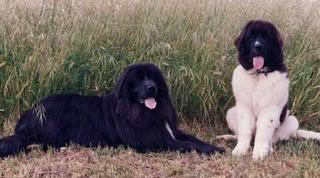Dogs and Soccer!!!

Breaking News !!
Reds hold on for a 1-0 victory.
Landseer, latest soccer sensation!!
This gallery photograph of our Newfoundland Dog, "Biggles", proudly posing after his quick intervention in a game of soccer.
It wasn't an intentional game, it all started on one of our daily strolls. It was a quiet Sunday morning in the park, not many people around and with him being of good nature we decided to let him off leash. No problem, he sticks to your side like butter eyeing your every movement. Well, as you can imagine we walked pass the local soccer field where a friendly game of soccer was in progress, blue stripped jerseys were attacking from the left towards the solid reds on the right. A long through ball was placed towards the forward on the right edge of the field. The attacker controlled the ball and easily side stepped the defender to head towards the goal. Clearly this was a very serious situation for the red team with only the goalie standing there to defend their precarious 1-0 lead.
Before we new it, "Biggles" our Newfie was away. A mighty fine slide tackle ensued and up he pops, game ball. Of course there was a mighty whistle from the referee, with the game coming to a halt. "Biggles" stopped in his tracks gazing at the referee with the soccer ball hanging from his mouth. The referee walks sternly up to him and does no more than to show him the red card, the game's over for him.
Disappointed, he walks slowly towards us with his head hung low, but in his mind we know what he's thinking, the reds still retain their 1-0 lead.











